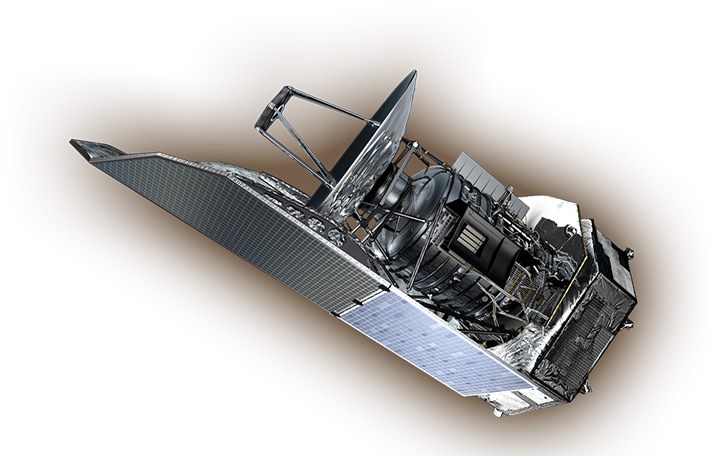Galaxies
Some time around its one billionth birthday, the universe emerged from its Dark Age into an era full of brightly burning galaxies. How that happened, and how the universe of that time led to the one in which we live today, are among the most intriguing and compelling puzzles facing science.
Most of the light reaching us from primeval galaxies is in the far-infrared and submillimeter range, and remains largely undetectable until Herschel begins operation.
What we have been able to see so far tells us that the story of the early universe involves supermassive black holes, dwarf galaxies colliding into each other, starbursts, and lots of gas and dust.
Herschel's ability to see through and derive information from that gas and dust enabled it to add greatly to our understanding of early-universe residents and how they are related to each other and to the modern universe. It also enabled us to learn much more about parts of our local universe - such as the core of the Milky Way - that are concealed by dust from other kinds of telescopes.
Herschel helped to answer some fundamental questions: Did galaxies all form around the same time in the early universe, or is galaxy-formation an ongoing process that continues today? Did stars lead to galaxies, or galaxies to stars? What kind of objects existed in the early universe? And how did they evolve over the eons into the galaxies of today?
Active Galactic Nuclei
Among the stranger objects that appear to have populated the early universe are active galactic nuclei (AGNs). As the name implies, these are galaxies in which the cores emit vast amounts of energy, far outshining the rest of the galaxy.
AGNs are classified as quasars, blazars, and Seyfert galaxies. Quasars are found mostly at tremendous distances, indicating the very early universe. Blazars, which appear even brighter, are probably quasars that happen to have a radio-emitting jet pointed straight at us. Seyfert galaxies appear to be closer (and so less ancient) and less energetic. They may actually represent a later, quieter stage of quasar evolution.
AGNs shoot vast amounts of energy out into space in two enormously powerful jets, one at each pole. In the vast majority of observed cases, a donut-shaped ring, or torus, of orbiting gas and dust lies perpendicular to the jets.
It is generally held that all three types of AGN are really the same kind of object. The perceived differences result from actual differences in their energy output - which could be as much as several billion suns - and also from the angle at which we view them. If an AGN happens to be situated so that one of its jets faces Earth head-on, we get the full impact and it looks extremely bright. If instead we're positioned so that we see it through the edge of its dusty torus, with the jets angled away from us, it appears dimmer.
What makes AGNs so powerful? Supermassive black holes almost certainly play an important role.
Monster in the Middle
Black holes are objects in which so much mass is concentrated in such small volume that nothing - not even light - can escape its gravitational pull. A massive black hole has recently been detected at the center of our galaxy, the Milky Way, and astronomers think these ultradense objects may be typical features of galaxies. Black holes can be so gravitationally strong that they twist space along with them as they rotate!
AGNs are thought to contain supermassive black holes at their centers, which suck in material from an "accretion disk," a ring of dust and gas that may include matter drawn from nearby stars or even captured galaxies! As the material spirals into the black hole, it heats up to enormous temperatures and emits radiation. Magnetic fields channel the radiation into polar jets, perpendicular to the disk.
The brightness of an AGN tends to vary over time, perhaps reflecting changes in the amount of its available fuel supply.
While AGNs have been detected by telescopes sensitive to optical and higher frequencies, it is thought that those observations tend to be of the later stages, when the objects have exhausted or blown away most of their dusty envelopes. Looking at far-infrared and submillimeter wavelengths, Herschel should be able to observe younger AGNs, still enshrouded in the dust that feeds them.
Herschel was able to help scientists answer some perplexing questions:
Which came first - black holes or the galaxies in which they reside? Does a black hole somehow form, and then draw the makings of a galaxy around it? Or does a galaxy form first and then have its center collapse into a massive black hole?
Did AGN-type galaxies evolve into ones like the Milky Way and its neighbors? Is the Milky Way's core black hole a potential AGN?
Starbursts
Black holes may not be the only kind of engine that drives AGNs. Starbursts may also play a role. Herschel should help scientists sort out how much each kind of phenomenon contributes to the enormous energy of an AGN.
Starbursts are intense bursts of star formation. They are thought to occur when shock waves compress vast clouds of gas and dust to the point where they collapse and form stars at rates up to hundreds of times greater than "normal" galaxies.
These new stars burn fast and bright, then the larger ones explode as supernovas, generating more shock waves and renewing the star-formation process. This chain reaction probably lasts ten million years or so - a relatively brief time in the life of a galaxy - until most of the gas and dust is spent.
IRAS, an infrared telescope satellite, discovered thousands of starburst galaxies. Herschel studied them and discovered more, taking advantage of its sensitivity to the infrared emissions of the dust clouds.
When Galaxies Collide!
What causes the shock waves that trigger starbursts and, possibly, massive black holes? One probable cause is galactic collision.
We know that galaxies collide today. Our own Milky Way shows signs of having swallowed another galaxy in the distant past, and is headed for a run-in with the Andromeda galaxy in three billion years!
In the early universe, galaxies must have bumped into each other much more frequently than they do now. Since the universe is expanding, the early universe must have been considerably smaller. Galaxies would have been closer together and able to feel each other's gravitational pull more strongly. They were likely drawn to each other much more often than is the case today.
Though it may sound like the title of a science-fiction disaster movie, what really happens when galaxies collide is a gravitational dance lasting billions of years, which produces beautiful swirls of stars, intense bursts of star formation and often - we think - an elliptical galaxy at the end.
Galaxies are not solid objects, of course. They consist of stars separated by vast stretches of empty space. So when galaxies "collide," they spiral around each other for a few eons, and then may pass right through each other before they settle down as one new, larger galaxy.
You might say that what actually collides are the galaxies' gravitational fields. Galaxies pack a lot of gravity, the sum total of all their stars, interstellar gas and dust, and whatever "dark matter" they may include. Two or more galaxies passing close to or through each other can drastically alter each other's structures. Stars may be whipped out of their home galaxies on long tails, drawn into a bridge to the other galaxy, or driven together into hot clusters.
There is a profound effect, too, on their huge interstellar clouds of gas and dust. Shock waves can compress them to the point where they trigger starbursts. And something in the process - maybe the shock wave itself, maybe the starburst activity - might help massive black holes to form or at least to grow.
The process of spiraling into each other and ultimately merging can take a billion years or more. So when astronomers observe galaxies in the act of merging, they don't see the motion of the galaxies falling in toward each other. Rather, they see the galaxies apparently motionless, at whatever phase of the interaction they happen to be. They may be moving at breakneck speeds, but the distances are so vast that from our point of view, the motion is imperceptible.
So astronomers scanning the skies are apt to find galaxies that appear to be frozen at all different stages of interaction and merger (one of which is thought to be responsible for ultraluminous infrared galaxies.) Herschel will be used to study all the stages of galaxy interactions.
By studying galactic mergers in the local universe, which can be seen in detail, Herschel can help scientists interpret what it will uncover in the early universe. And by observing mergers at a range of ages, Herschel will help to determine whether merging can lead to present day elliptical galaxies.
Building Blocks
Galactic mergers are likely the means by which smaller "building blocks" grew into larger galaxies like those of today, each of which may have as much mass as a billion or more suns.
It is commonly believed that there are many "small" galaxies of only a few million solar masses in the distant, early universe, which are yet to be discovered. Infrared background radiation detected by the COBE satellite, launched in November 1989, supports that idea.
The first sighting of one of these possible building blocks was made in October, 2001 by the Hubble and Keck telescopes, with the aid of a gravitational lens.
A gravitational lens is an effect in which light from a distant source is bent by the gravitational pull of an intervening galaxy cluster in such a way that the image is magnified when it reaches us. It can make it possible to see objects that would otherwise be too dim to detect.
The Hubble-Keck sighting was made at optical wavelengths, the light frequencies visible to the human eye. Scientists expect to see as many as 1000 times more gravitationally-lensed primeval galaxies at the sub-millimeter wavelengths that Herschel will detect than in any other waveband.
The galactic building blocks would presumably contain little or no heavy elements, since their component stars would not have had time to manufacture them. Herschel will study local blue compact dwarf galaxies, which have similar compositions, as models for their primeval counterparts.
Local News
Herschel also contributed greatly to knowledge about galaxies in our local part of the universe.
It enabled scientists to get a really good look at the Milky Way's dusty core, including its recently-discovered black hole.
It studied the evolution of neighboring galaxies to shed new light on the development of elliptical galaxies and spirals like ours.
Herschel surveyed nearby bright galaxies to determine how the spectra of gas and dust is affected by galactic rotation, density waves, tidal forces, winds and turbulence. This provided valuable insights that can be applied both to our local universe and to observations of the dim, distant past.







